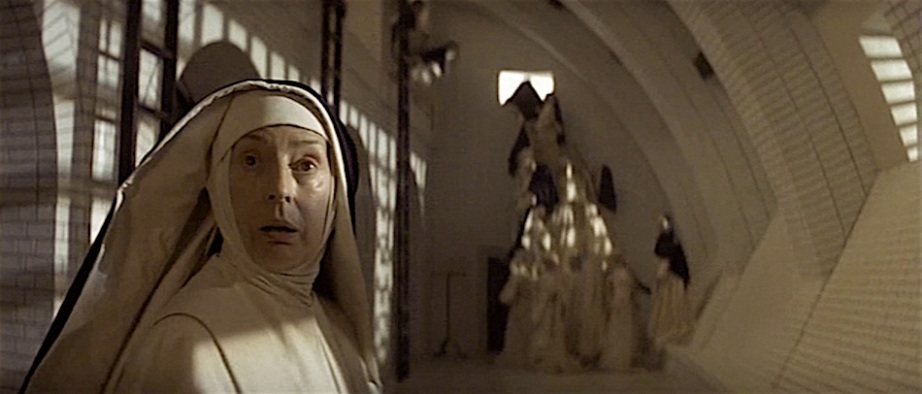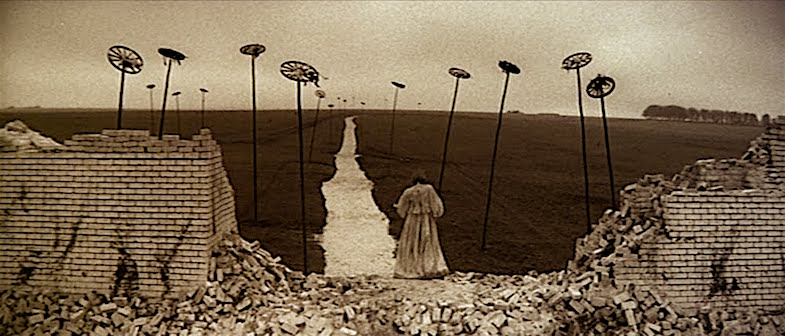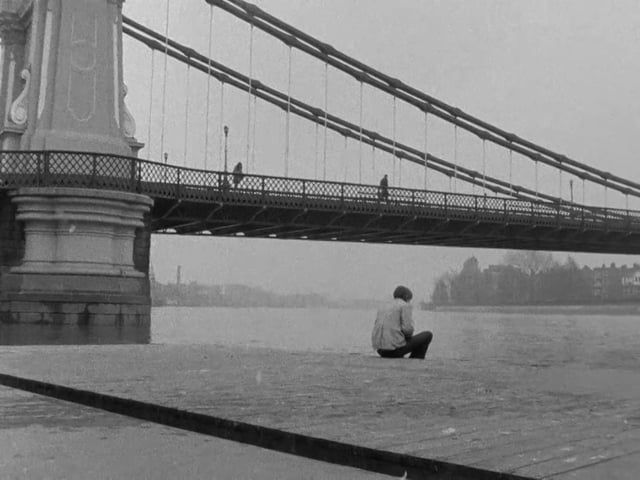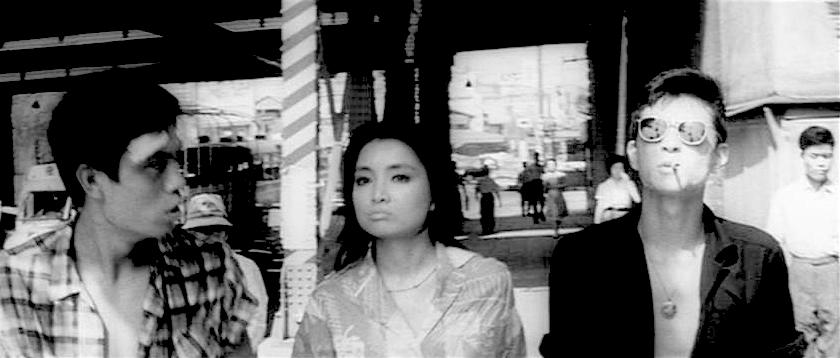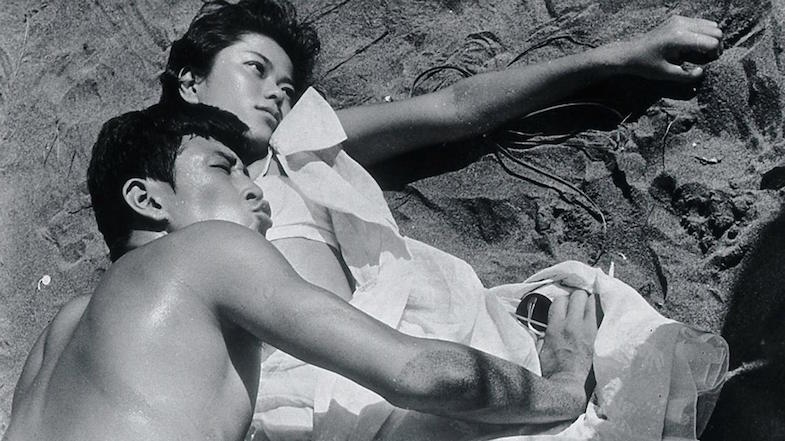When David Lynch and Mark Frost initially pitched the concept that would become the TV series, Twin Peaks, the idea was really about creating a satire on American small town culture. The show’s mystery of “Who Killed Laura Palmer?” was intended to take a backseat to the show’s plot once the quirky characters identities and respective double lives gained the audiences’ interest. Starting off with a two hour special pilot that truly brought a whole new level of quality and subversion to the firmly entrenched ideology of small town American life. It was during the run of Twin Peak‘s first season that the idea of “Lynchian” would truly take form. This series was less a satire of soap opera and television mysteries as it was a subversive and highly experimental experience.

“In a town like Twin Peaks, no one is innocent.”
Twin Peaks: Fire Walk With Me
David Lynch, 1992
To the eyes of 21st Century eyes, this series might seem tame. But in 1990, this was shocking and pushed the boundaries of what was being shown on television. It was also far more “cinematic” than standard television. The pilot was a slam-dunk hit. The ratings took a significant drop after the two hour pilot. The ratings for the rest of season one were not consistent, but never truly low.
This show was being, watched, discussed, analyzed and studied. Twin Peaks gained an almost instant cult following. Contrary to Lynch and Frosts’ idea, the mystery of Laura Palmer’s death never moved to the background. Despite already being dead and presented only in the now iconic photograph and limited POV screen captures, Laura Palmer was the driving force of the show. There a number of logical reasons that the idea of each character’s dual personas never became the vital interest(s) of the viewers. For those of us old enough to remember when this ground-breaking television show premiered, there was something alluring about that image of the seemingly perfect All-American Prom Queen captured in a High School year book photograph. There something intriguing about the beautiful yet somehow ethereally strange look of Sheryl Lee’s photograph as Laura Palmer. Like every other character roaming the streets and dirt roads of Twin Peaks, Laura Palmer had a double life. And both sides of Laura’s identity seemed to serve as a trigger for every other character on the show. The fact that we slowly gained information that she may not have been the sweet Girl-Next-Door or the earnest Meal-On-Wheels volunteer was far more curious than any of the living characters on the show.
The public wanted to know more about her and most of all wanted to know who killed her.
This, of course, would be the show’s undoing. Lynch and Frost had never really solved this mystery. Resolution of Laura Palmer’s killer was filmed in several different ways. It quickly became a an odd Pop-Culture Moment. A moment in which much of the audience was watching closely to see where all of the many clues being offered between, above, under and around all of the disturbing, comical, supernatural and off-kilter perspectives were pointing.
The final episode of season one had a huge rating. I can remember sitting in a room full of fellow college students to see who “iced” Laura. But Lynch and Frost did not reveal the killer. Simply more intense clues. It would not be until season two that Laura’s killer was finally revealed to be her father. The mystery’s ultimate resolution made perfect sense for David Lynch’s continuing artistic examination beneath the tainted soil upon which Middle America stood, but was also somehow unsatisfying. It also made all the hints toward the paranormal suspect.

The Good Witch descends to offer some advice for Sailor…
Sheryl Lee
Wild At Heart
David Lynch, 1990
Cinematography | Frederick Elmes
Lynch remained involved with the TV series, but in many ways he might as well have left.
Twin Peaks was really a stunningly brilliant artistic experiment, but David Lynch’s true interest was/is grounded in cinema. While it may not be his finest hour as a filmmaker, 1990’s Wild At Heart, remains my personal favorite David Lynch film. A road movie from Hell, the adventures of Sailor & Lula almost felt like Lynch had been given free reign to create this gleefully surreal and perverse exploration. And wait. Isn’t that Laura Palmer giving Sailor advice? Advise which led his character to deliver a perversely politically-incorrect apology to those thugs?!?! When we saw Laura Palmer (Sheryl Lee) come down from the heaven’s to help Sailor get back on track, it seemed like possibly another clue.
As die-hard Twin Peaks fans were now sorting through Jennifer Lynch’s clever The Secret Diary of Laura Palmer to sort out the show’s red herrings from true relations, the iconic television series took a quick downward spiral. Twin Peaks‘ first season directors were hand-picked by both Lynch and Frost. But the with the doomed second season the show’s director choices were disjointed and ill-fitting to the original concept. Everyone from Uli Edel to Diane Keaton took the director’s chair. It was canceled and ended in June of 1991. I had just graduated from University and relocated across the country as the second series started. I had no TV, but my interest in the show had faded to disappointment.
Wild At Heart was an Art House film. It was far from a box office blockbuster, but it added value to the director’s reputation. It was also the hit of that years Cannes Film Festival. And even though the industry may have viewed Twin Peaks as a sort of Cult TV Oddity that had ultimately failed, Lynch was in a fairly good position professionally.
Where would he go next?
What new strange world would he create for the cinema?
As it turns out Twin Peaks was still strong on his mind. Many of the ideas he had originally had for Twin Peaks had to be pushed aside to sort of conform to the standards and regulations of Network Television. He had the funding both from America and France to do what he wanted. And he could do it the way he wanted. David Lynch decided to return to the world of Twin Peaks, but this “re-visit” would be a prequel.

How does a cinematic genius top a TV Series that changed the face of network television? He breaks it…
David Lynch as FBI Agent Gordon Cole
Twin Peaks: Fire Walk With Me
David Lynch, 1992
Cinematography | Ronald Victor Garcia
This would be the opportunity for the show’s legion of fans to actually meet that beautiful High School Prom Queen gone wrong. It would also offer David Lynch the opportunity to actually work with the actress who had set so many hearts and minds a-flutter. Sheryl Lee was more than a simple, engagingly beautiful face — She possessed charisma and an interesting on-screen energy. She was and is an extremely talented actor. Lynch was to make a motion picture focused on the final week in the life of Twin Peak‘s most alluring citizen, Laura Palmer. To the film’s backers, this seemed the perfect idea. To the legion of Twin Peaks fans news of the film set hearts aflame.
What no one seemed to think about was that this was not going to be a normal sort of prequel. And for those of us who thought Wild At Heart presented David Lynch at his most unfiltered and unrestrained, we were about to discover we were wrong.
Twin Peaks: Fire Walk With Me was not so concerned with much from the original series and this film presented David Lynch’s cinematic vision completely unbridled. He had no plans of returning the audience to the same beautiful but provocatively seedy small town. Without censor, without a Major Television Network breathing down his neck, Mr. Lynch took us back to the same town. But now we saw it from a completely different vantage point.

“If I had a nickel for every cigarette your mom smoked, I’d be dead.”
Twin Peaks: Fire Walk With Me
David Lynch, 1992
Cinematography | Ronald Victor Garcia
Now working my way up the corporate ladder in Boston, I stood in line with two new friends to catch a 1992 midnight premier screening of the film. We had all heard it had been met with jeers and booing at The Cannes Film Festival, but it just didn’t seem possible that the movie could be bad. Fire Walk With Me may not have been the movie the television show’s cult following wanted to see, but it was one hell of a cinematic ride. A sort of hot-dripping Freudian fever dream. Or perhaps more accurately, seeing this experimental film on a big screen was like being dropped into an Edvard Munch painting gone very wrong.
Twin Peaks: Fire Walk With Me didn’t just take the iconic TV Series to a new level, it jolted that quirky universe into a whole new cinematic galaxy.
The opening moments of the film feature a television screen on scramble. A vision we no longer see in the 21st Century. The opening scene of this television’s screening scrambled mess indicates that we are on a dead channel or that the National Anthem has already played and the channel has closed for the viewing day. But then, just as Angelo Badalamenti’s potent score finally seems to reach a clear volume and credits have screened — this television is literally destroyed. A sharp and horrifying woman’s scream and the TV is obliterated.
David Lynch has just destroyed the restrictions and limitations of not only his TV series, he has broken out of the very concept of television itself.
As the film starts we realize that the murder of Teresa Banks has just taken place. Her body wrapped exactly like that of Laura Palmer floats on the water. The film’s first iconic image or scene is one that is never explained, but it carries an odd and comical impact. We first see Special Agent Chester Desmond arresting two grown women at the side of a school bus filled with screaming and crying children. The bus seems to be parked in an open field. Nothing about this scene is treated by the adult characters as odd or strange. Yet it is an unforgettable little scene that sets the film’s space.

Unexplained situation: An FBI drug bust and a school bus full of terrified children…
Twin Peaks: Fire Walk With Me
David Lynch, 1992
Cinematography | Ronald Victor Garcia
While nothing was as it appeared on Twin Peaks the TV show — in the movie’s Twin Peaks the same holds true with a major difference: Nothing even appears “right” or “normal.”
There is a constant auditory and visual discord at work. Surrealism and Absurdism is closely tied to whatever “reality” we may be shown. In the television series, actors played their characters with an edge of hamminess and often camp. In the Twin Peaks film, the actors are performing as if stuck in some vacuum that is constantly threatening to suck them up into oblivion. The acting here is not so much about “camp” as much as it is about keeping in step with the energy of David Lynch’s subversive, perverse and often hysterical vision.
David Lynch re-creates his own character from the TV series. The hearing-impaired Agent Gordon Cole summons Chris Isaak’s Special Agent Desmond to meet him. In typical Twin Peaks‘ logic, this meeting is simple and yet complicated.

“Her name is ‘Lil'”
Kimberly Ann Cole
Twin Peaks: Fire Walk With Me
David Lynch, 1992
Cinematography | Ronald Victor Garcia
Gordon Cole leads Agent Desmond over to meet an odd woman who seems to be hiding inside a small airplane hanger. As she emerges, Gordon explains that this is his “mother’s sister’s girl, Lil“. Lil proceeds to make a sour face.
What’s a sour face? Well, that is a face that has a sour look on it.
Lil keeps one hand in a pocket of her ill-fitting dress. Opens and clenches her other hand into a fist and stomps in place. Later Special Agent Chester Desmond explains to the confused Forensic Pathologists what this meeting of Lil actually meant:
Sour Face = problems with local authority awaits
Both Eyes Blinking = trouble with the higher-ups
One Hand in Pocket = something is being hidden from the FBI
Fist = there is a whole lotta beligerence
Walking In Place = there’s going to be a lot of legwork
Dress Tailored To Fit = this is code for drugs
Blue Rose Pinned To Lil’s Dress = “I can’t tell you about that…” Meaning that the agent is not comfortable revealing this meaning to Kiefer Sutherland’s befuddled pathologist.

What was missing in Agent Cole’s introduction for Lil? …No uncle is mentioned.
Kimberly Ann Cole
Twin Peaks: Fire Walk With Me
David Lynch, 1992
Cinematography | Ronald Victor Garcia
Already well over ten minutes into the film and David Lynch has yet to bring us back to Twin Peaks. It is not far away, but as we watch the Special Agent and Forensic Pathologist navigate the odd waters of their location it feels more like the familiar world we knew in the television series. After a particularly grueling autopsy of Ms. Banks, the intrepid men go to a local all-night cafe. The same cafe that had employed Teresa Banks. A comical question and answer with Teresa’s former co-worker reveals that Teresa was involved in drugs.

“Who’s the towhead?”
Sandra Kinder as “Irene” That is her name and it is night. Don’t go any further with it. There’s nothing good about it.”
Twin Peaks: Fire Walk With Me
David Lynch, 1992
Cinematography | Ronald Victor Garcia
Then we follow them to the Big Trout Trailer Park where we are led by a hilarious Harry Dean Stanton as the park’s manager to Teresa Banks’ home trailer. It is here that Surrealism and an ever-menacing level of horror creeps onto the screen.
Loose ends from the series continue to pop up. The hanging electric lines seem to emit a sort of horrific transmission or energy. This is new.
Poor Special Agent Chester Desmond vanishes into an unexplained sort of paranormal vortex. As Kyle MacLachlan enters the film as Special Agent Dale Cooper we finally are treated to feeling like we may be back in the familiar territory.

Special Agent Chester Desmond’s abandoned car.
“Let’s Rock”
Kyle MacLachlan and Harry Dean Stanton
Twin Peaks: Fire Walk With Me
David Lynch, 1992
Cinematography | Ronald Victor Garcia
Special Agent Dale Cooper also pays a visit to The Big Trout Trailer Park, but his reasoning doesn’t seem to match-up.
It is not too long after he and Harry Dean Stanton look at Agent Desmond’s forgotten car and study a lip-stick written message on the windshield that we will soon hear Badalamenti’s familiar theme song and see the famous opening to the TV series.
Pulses raced as the film came to this point. At long last we would finally actually meet Sheryl Lee’s Laura Palmer. Since the TV series began she had been seen only as photographs or brief glimpses. Or most annoyingly, as a doppelganger brunette cousin.
But now we will see, hear and get to know Laura Palmer.

And now, Ladies & Gentlemen, meet your all-American Prom Queen: Laura Palmer. Beautiful, dazed, confused and abused.
Sheryl Lee
Twin Peaks: Fire Walk With Me
David Lynch, 1992
Cinematography | Ronald Victor Garcia
The actual return to Twin Peaks and meeting Laura Palmer was not what anyone quite expected.
Just like the high school Prom Queen photograph, that charismatic look does transform into an even stranger mix of beauty and somehow perverse energy all channeled brilliantly by Sheryl Lee.
Within what we now call Lynchian Cinema, his female actors are essential keys. Both Laura Dern and Naomi Watts are pitch-perfect actors for David Lynch. Both are deeply skilled actors, have on-screen presence / charisma and have the ability to at once convey an All-American kind of blond beauty and ambition. They also are fairly fearless performers who are unafraid to tap into the darker and obscure aspects of humanity without crossing the line into “camp.” Isabella Rossellini was also a key actor for David Lynch. She may not be the greatest in level of skill, but she carries a bizarre mix of beauty, innocence and with a strange lean toward the perverse. Rossellini fit into Lynchian Cinema with ease. Sadly, due to complication of a romantic relationship we were only able to enjoy her within this world twice.
However, Grace Zabriskie is without question the ultimate David Lynch actor. In Fire Walk With Me, we see Mrs. Palmer before one of life’s truest devastating losses has caused her to become unhinged in her despair, sorrow, guild and grief. Here Zabriskie is given a surprisingly small but difficult challenge: establishing Mrs. Palmer as a damaged person. Of course, this fine actor was more than up for the challenge.

Mom knows something is very wrong, but she is Dad’s victim too.
Grace Zabriskie is Mrs. Palmer
Twin Peaks: Fire Walk With Me
David Lynch, 1992
Cinematography | Ronald Victor Garcia
Already a solidly employed and respected actress, when David Lynch first cast her, she found the perfect film artist to assist her in channeling her unforgettable energy and presence. A highly skilled actor, Zabriskie is able to easily convey human emotion realistically — but most importantly, she can access them in the most inappropriate, perverse and hysterical of ways.
She walks the tight rope with ease: Camp and B-Movie Exploitation Horror await her slip and fall, but she never loses her balance. She straddles the lines between Realism, Surrealism and Absurdism without any sputtering or error. Like the other three actors, she is beautiful. Also like the other three, her beauty is somewhat convulsive. Unafraid of aging, this actress can summon a great degree of sexual allure in the strangest and most menacing of ways. Another shared gift all four of these actresses: they are likable. It is almost impossible not to root for Ms. Zabriskie even in the darkest and evil of roles.
While those four actors have experienced amazing success working for David Lynch, the same luck did not hold true for Sheryl Lee. It is perhaps the greatest fail of Twin Peaks: Fire Walk With Me that Sheryl Lee’s career was that it almost completely de-railed it.
It is impossible to watch this film and not note the incredible Movie Star Presence she exudes. Sheryl Lee also presents a chillingly accurate performance. This is an actor with a great deal of skill. And, like Zabriskie, she is able to easily walk that line between Realism and The Surreal. Like all of the above mentioned actresses, she is very likable on screen. And, in reality, there is probably only one of the four who could rival her beauty and that would be Rossellini.
However Sheryl Lee possesses an easy access to eroticism that is not quite as easy for the other actors mentioned. Sheryl Lee was and remains a hot-looking actress. Never extreme, convulsive or too thin — her shape is always right on form with erotic ideal. And even when she flaunts it and teases, there is something fragile at play that makes the viewer want to protect her.

High school journal keeping has never been this erotic or perverse…
Sheryl Lee
Twin Peaks: Fire Walk With Me
David Lynch, 1992
Cinematography | Ronald Victor Garcia
Another key trait for a David Lynch actress, Sheryl Lee has no fear. In Fire Walk With Me she goes for broke in some of the most uncomfortable scenes. Most if not all of her scenes in this film act almost as individual Cinematic Abstract Art Pieces. She is given some of the oddest and most difficult lines of any Lynchian character. In an early scene we see an in-between classes sexual encounter between Laura and her love-sick suitor, James. James attempts to make her understand how much he loves her and that he can protect her from anything. The lines in this scene are intentionally comical, but at the same time carry an skewed sense of tragic truth within this warped film:
Laura refuses James’ love.
“I’m gone. Long gone. Like a turkey in the corn.”
“You’re not a turkey. A turkey is one of the dumbest birds on earth.”
“Gobble-gobble. Gobble-gobble.”
Even though you will find yourself chuckling or laughing, Sheryl Lee manages to evoke a damaged sort of “gobble” that haunts.
While the actor playing James handles the scene like a bad soap opera, Lee takes the wording and invests them with meaning. Yet, she never allows her skill to get in Lynch’s way. Sheryl Lee “gets it” and she takes that understanding and runs with it throughout Lynch’s experimental exploration of human cruelty, horror and abuse via means of the human psyche.
Having just had the rare opportunity to rematch the film via a pristine and new 4K transfer that will hopefully find it’s way to US distribution. It is miles ahead of the Region-Free German Blu-Ray and certainly far better than the treatment it received by Paramount in last year’s Twin Peaks box set. Criterion, are you there?
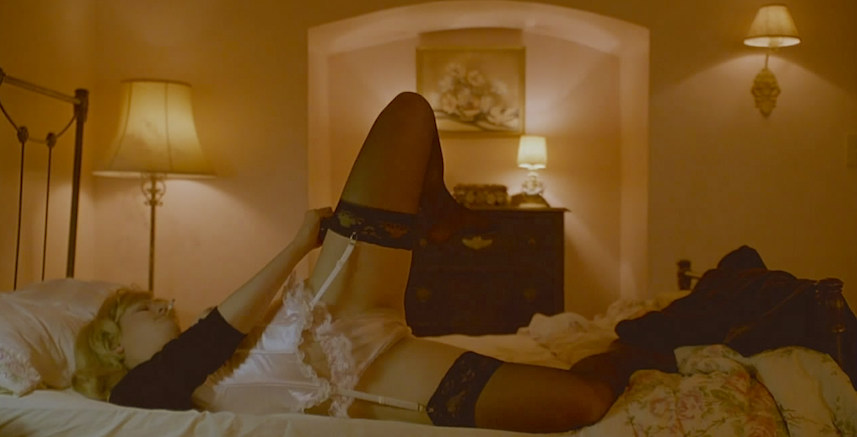
Prom Queen, a diary, some booze, a bit of coke and a lot of eroticism.
Sheryl Lee
Twin Peaks: Fire Walk With Me
David Lynch, 1992
Cinematography | Ronald Victor Garcia
Sheryl Lee should have become a major player in the world of filmmaking. Yet the film’s failure and her achingly-inter-connected performance was misjudged. Sheryl Lee’s work in this film is an exact match to Lynchian negative energy and dire need of redemption. Like the film itself, Sheryl Lee never falters as both she and the film go exactly where David Lynch wanted it to go.
Grace Zabriskie has stated that she felt that Lee gave so much to David Lynch and the character while filming the movie that it took her several years to find her way back to herself. This might seem like an “over-the-top” statement, but when discussing the art of Method Acting and The Method Actor, it is painfully accurate. As hard as Sheryl Lee worked to give Lynch what he needed, he would push her even harder. The film obviously left the young actor exhausted, but the film’s critical and commercial failure were most likely like receiving a universal gut punch.

The Log Lady offers a bit of comfort and a warning that serves as key to the strange world in which we roam…
Sheryl Lee & Catherine E. Coulson
Twin Peaks: Fire Walk With Me
David Lynch, 1992
Cinematography | Ronald Victor Garcia
When the midnight screening I attended in 1992 reached the closing credits, I felt as if I had been on some strange metaphysical trip of a cinematic ride. I had been entertained, horrified, engaged and left in awe. However, my two friends and what felt like the entire sold-out audience had hated it.
People in the cinema literally Boo’d at the screen. A couple of folks even threw their popcorn containers at the screen. I was confused. As I stumbled back into the reality of a hot New England evening, I was equally disoriented and excited.
The Boston bars had closed, so the three of us retreated to a now long-gone sort of coffee-house that served the homeless, the collegiate and hipsters in equal fashion. It was a favorite hang-out. We had some cookies and coffee and discussed the movie.

Is Laura Palmer living in a very bad dream? Here she walks into a room that is more than a little too familiar.
Twin Peaks: Fire Walk With Me
David Lynch, 1992
Cinematography | Ronald Victor Garcia
All three of us holding degrees in English, we all shared a love for deconstructing art. Each of us had a different read on what we had seen:
One of my friend’s felt it was an “Anti-Movie” through which David Lynch was laughing and giving the finger to his audience.
My other friend felt it was a sort of cinematic mistake. She pointed out that the use of Surrealism and Absurdism was pointless if neither had meaning. Unlike my first friend, she saw some merit to the movie. But I can remember her drawing her long orange finger nail between herself and me stating that the film’s flaws out-weighed the few points Lynch had made correctly.
I disagreed with both opinion. I felt they were being too superficial and lazy.
I sipped my coffee and told them that I felt the film was a spectacular experiment in exploring the psyche of a pedophile incest rapist and most alarmingly the psyche of his victim. I explained that the entire theme of the film had been quite poetically summed up by Catherine E. Coulson’s Log Lady. This film had pulled us into a confusing vortex of insane human cruelty, confusion caused by child abuse, the impact resulting in a family / friends all living in a faked level of love, conformity and insincere sincerity. The despair, the pain, the guilt and the sorrow of both the victim and the victimizer are identities constantly walking with a fire that threatens to consume them at any moment.
My two friends sat with this for a few minutes. One started to laugh. The other’s head seemed tilted all the way on our respective walks to Muni, dorm and home.

A dream captured in a frame…
Twin Peaks: Fire Walk With Me
David Lynch, 1992
Cinematography | Ronald Victor Garcia
If you’re wondering why I recall so well what we discussed and how we discussed it — it is because I have been a chronicle journal keeper since I was 18. Upon arriving back to my tiny basement apartment at 4am, I opted to write the experience down instead of sleeping. As I had to be at work for 7am it seemed a more rational use of my time. It staggers my mind to think that I could function at work without any sleep. Ah, youth.
But I digress.
Many view the movie as a complicated mess of a prequel with no other aim than to inform the Twin Peaks fans of Laura Palmer’s last week of life. This seems far too simplistic. David Lynch is far too intelligent a filmmaker to have discarded almost all of the television series atmosphere and style had this been his intent. If this were all he wanted to do the film would have been shorter and no TV set would have required breaking.
Others view it as an admirable cinematic error. One can’t really argue with this view-point. This film is so untethered, it is impossible to anticipate that everyone will like or even passively accept it. But I still stand by my opinion formed in 1992.

The angels never really went away. Laura’s salvation descends…
Twin Peaks: Fire Walk With Me
David Lynch, 1992
Cinematography | Ronald Victor Garcia
Essentially this film is examining the ways in which “we” absorb the horrors of our lives into our psyches so that we can simply continue moving forward. Full acceptance of truth is far easier said than done. Anyone who has fallen victim to someone we should have been able to trust — or, more simply put, anyone who has been sexually abused by a family member or a trusted family friend will understand that “owning” the reality of pain/sorrow caused by sexual violation/abuse is actually more difficult than the violation itself. And PTSD is not just limited to survivors of war. PTSD can kick your ass. And it kicks it in really strange and often metaphorical ways that can cause a person to mask their own personal truth as well as take on the guilt that they have no business absorbing. The victim has done nothing wrong, but under the reality of life’s light — it can feel quite the opposite for the victim who survives.
Most of the time that monster in the closet or under the bed is just normal childhood fears, but other times there really has been a monster there.
When The Log Lady runs into Laura Palmer about to enter the Twin Peaks Townie Bar, she gently touches Laura’s face and offers a parable that applies to the entire film:
“When this kind of fire starts, it is very hard to put out. The tender boughs of innocence burn first, and the wind rises, and then all goodness is in jeopardy.”

Is “Bob” Dad’s creation or one of his daughter? Worse yet, is Bob a demon? The American Family gets a horrifying surreal deconstruction.
Ray Wise as Mr. Palmer
Twin Peaks: Fire Walk With Me
David Lynch, 1992
Cinematography | Ronald Victor Garcia
There is an-ongoing “discussion” of pain and sorrow, fire and angels throughout the film. It begins when Laura and her best friend contemplate life. Laying in the living room, Donna shares a dream-thought and then an odd question:
“Do you think that if you were falling in space that you would slow down after a while, or go faster and faster?”
Laura suddenly seems to be miles away from Donna as she stares off into some doomed distance, yet she has heard her friend and answers, “Faster and faster. And for a long time you wouldn’t feel anything. And then you’d burst into fire. Forever. And the angel’s wouldn’t help you. Because they’ve all gone away.”

The Angel feeds and watches over the children.
Twin Peaks: Fire Walk With Me
David Lynch, 1992
Later, Laura will see an angel represented in a childhood framed image in her bedroom vanish before her eyes. The three children in the painting are no longer fed or protected by the watchful angel.

The Angel has gone away
Twin Peaks: Fire Walk With Me
David Lynch, 1992
And of course there is that strange room that appears in Laura’s dreams and is presented to her by an old woman in a framed photograph. And The Other Place where The Man gives information with backward masked commentary. These visions are shared. The Lynchian concept of creamed corn comes into play. Referred to as “garmonbozia.”
The meaning of this term has been much analyzed by the legions of Twin Peaks fans as well as Lynch Heads. Creamed corn is mentioned in relation to Laura’s role as Meals-On-Wheels volunteer, Mr. Palmer is accused of stealing a can of it and it appears in visions. Garmonbozia is a demented symbol of pain and sorrow. A pain and sorrow both inflicted and inflicting. The normal thought is that there are two things that all inhabitants of Twin Peaks share:
- A darker / hidden aspect of their individual identities
- They each feed and give off pain and sorrow
Fire Walk With Me consumes itself with symbology and metaphors of fire, angels, masks, identity, a seemingly extra-dimensional red-curtained room, an owl ring, a one-armed man and most importantly the character of BoB.

The danger of the owl ring may be the only way out…
Twin Peaks: Fire Walk With Me
David Lynch, 1992
Cinematography | Ronald Victor Garcia
Bob is Laura’s monster hiding just outside her bedroom. As she confesses to her Meals-On-Wheels home-bound client, Bob has been having her since she was twelve. As the film progresses Laura becomes aware that Bob might be “real” but he might not be who or what he appears to be. In Laura’s self-deception, Bob is tearing out pages from her diary to exert his power. He knows everything about her — Bob knows all. Most repulsive for Laura is that as afraid as she is of Bob and the rapes, she has reached a point where the attacks are expected and she now seems to be finding some sort of sadistic sexual pleasure from these unwanted attacks. In a particularly disturbing scene as Bob takes her body, she begins to reach orgasm.
She moans, “Who are you? Who are you?!?!” Just as she slips into orgasm Bob turns into her father.
Her father’s behavior has become highly suspect for Laura and her her mother. Mr. Palmer seems to be forcing Laura into uncomfortable confrontations.
In one of the films more Extreme/Absurdist moments, Laura and her father are in his car. Suddenly the One-Armed Man is tailing them. Mr. Palmer begins to panic. The One-Armed Man is furiously attempting to communicate with Laura. Her father keeps the car racing even at a dead stop to drown out the man’s voice. A dog’s barking becomes as loud as the car, the One-Armed Man and the frenzied musical score. The impact of this scene is equally disturbing, annoying and almost funny.
During the strangely hysterical and frenzied scene, Laura thinks she smells fire.
Screaming above it all with increasing panic, “Dad! Something’s burning! Are we on fire??!?!?”

In a world of horror, it is easier to face Bob than Dad. This is the All-American Girl Next Door’s only way out.
Bob Silva & Sheryl Lee
Twin Peaks: Fire Walk With Me
David Lynch, 1992
Cinematography | Ronald Victor Garcia
Just before Mr. Palmer is able to shake the One Armed Man, he is able to reach Laura’s ear with information she does not want to have:
Holding out his one arm and a finger wearing the familiar owl ring, “It’s him! It’s your father!”
When we see Mr. Palmer drug his wife in their bedroom, Laura is jumping off James’ motorcycle off to her fate deep in the woods. We have reached the final night of Laura Palmer’s life.
Beaten, tied and dragged into an empty train freight car — Laura at first thinks she is facing Bob, the man who has abused her since she was twelve. But she quickly sees through her psyche’s self-deception: This is not Bob screaming at her. This is her father.

Brutally raped and threatened, is that Angel pointing toward an owl ring?
Sheryl Lee
Twin Peaks: Fire Walk With Me
David Lynch, 1992
Cinematography | Ronald Victor Garcia
And there lies the owl ring.
Most importantly, for the first time since the film has begun to unspool — Laura receives a sign of hope: An angel seems to be descending into the train car.
In what appears to be an act of ultimate rebellion, Laura scrambles for the owl ring. As her father pleads with her not to make him do “it,” Laura slips the ring onto her finger. It is as if this ring allows both the victim and the victimizer to gain full awareness. As the angel hoovers somewhere above them, Mr. Palmer kills his daughter.
Metaphorically, she has won. She has escaped and left him with his guilt, pain and sorrow. The creamed corn is now his and his alone. He must live with what he has done. As he wraps Laura’s body in plastic to set her into the lake, we see his face from Laura’s body’s POV and it switches back and forth between Bob and himself.
Mr. Palmer must accept what is to come. The dream or vision becomes a sort of reality as his entry to The Other Places emerges in the woods.

A pedophile, rapist and murderer: Dad prepares to have his torment, pain, sorrow and human cruelty.
Twin Peaks: Fire Walk With Me
David Lynch, 1992
Cinematography | Ronald Victor Garcia
He steps through an opening in the red curtains and enters that extra-deminsional room. The Man From The Other Place and the One-Armed Man are waiting for him. Soon Bob is standing next to Mr. Plamer. As Mr. Palmer begins to levitate, Bob is instructed to take away Mr. Palmer’s Garmonbozia.
Like some internal cancer, Bob removes the blood soaked pain and sorrow from Mr. Plamer’s gut and tosses it on the floor.
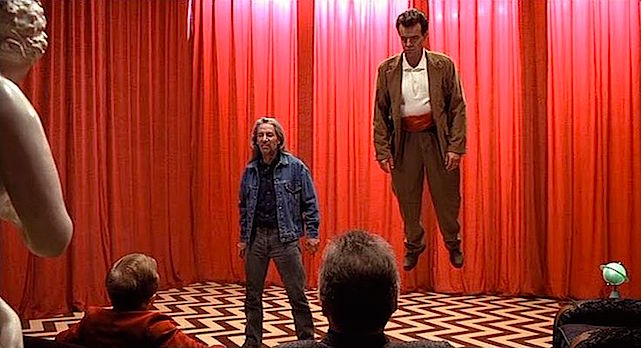
Faced with The One Armed Man and The Man From Another Place, is Dad releasing his own pain and sorrow? Or is Bob about to take care of that for him? Subconscious metaphor…
Frank Silva & Ray Wise
Twin Peaks: Fire Walk With Me
David Lynch, 1992
Cinematography | Ronald Victor Garcia
Of course the meaning of this scene has always been debated among Twin Peaks followers.
Is this an imaginary way for Mr. Palmer to once again to slip into his self-deception?
Is this a sort of heaven in which Mr. Palmer is freed of demonic power, Bob?
Or is this something loaded with a more universal way of dealing with guilt and the unforgivable?
In a strange and hyper-intensive scene early in the film we have seen David Bowie appear at Gordon’s FBI office. He is a long missing special agent and has come to give David Lynch’s Gordon a message. A series of jump cuts and audio editing led us to The Man From Another Place, the One-Armed Man, Bob and The Chalfonts. (you will need to see the film to know these two characters) — This is of particular note as it hints to where we might be going in the upcoming Showtime Twin Peaks re-boot.

Together in a dream or some alternate universe. Laura Palmer has a worrying connection to Special Agent Cooper.
“I’ll see you again in 25 years. Meanwhile…”
Sheryl Lee & Kyle MacLachlan
Twin Peaks: Fire Walk With Me
David Lynch, 1992
Cinematography | Ronald Victor Garcia
Going back to 1991’s final episode of Twin Peaks, Special Agent Cooper finds himself in the extra-deminsional red-curtained room with a lovely and calm Laura. She informs him that she will see him again in 25 years.
While David Bowie’s long-missing special agent attempts to give a message to his near-deaf boss in Fire Walk With Me — we only catch bits and pieces of what he says. But we do see him point to Special Agent Cooper and bellow to Gordon,
“Who do you think this is here?!?!?”
This message almost insinuates that Agent Cooper is some sort of Evil Being. Toward the end of the original series we know that Agent Cooper had begun to see Bob’s reflection when he looked into mirrors. Hmmm…
It will be more than a little interesting to see what David Lynch and Mark Frost come up with for their limited Twin Peaks run on Showtime.

Written in blood. Never before in television history has the grammar and meaning of a phrase been so analyzed and debated.
Twin Peaks: Fire Walk With Me
David Lynch, 1992
Cinematography | Ronald Victor Garcia
Whatever we do learn in this mini-series will have little to do with what David Lynch explored in Fire Walk With Me. This strange and much maligned Cult Film will most likely remain where it has always been. Sort of endlessly playing into subconscious in circular logic.
Take your creamed corn for what it is or what it isn’t. Fire Walk With Me is a message that lays on a mound of bloody soil. It might be confusing or even cryptic in meaning, but David Lynch wrote it in blood.
Matty Stanfield, 10.9.2015
